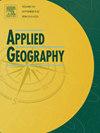How do urban amenities shape knowledge-intensive industry locations within cities? A multi-scalar study of Wuhan, China
IF 5.4
2区 地球科学
Q1 GEOGRAPHY
引用次数: 0
Abstract
Urban amenities are key factors in knowledge-intensive industrial agglomeration, yet their impact on cities remains underexplored. This study addresses this gap by proposing a multi-scalar framework that distinguishes metropolitan-scale effects, shapes urban structure, and establishes regional competitive advantages from local-scale amenities, whose availability and diversity drive placemaking. Using Wuhan's automotive industry as a case study, detailed firm-level data, comprehensive amenity information, and spatial econometric techniques were employed. Findings reveal that while automotive firms cluster near high-amenity urban sectors, local urban areas exhibit specialized industrial clusters. The regression results confirm that localized attractiveness is driven by both the availability and diversity of amenities, as well as the division of urban spatial structure. However, high availability is particularly valued for essential infrastructure and public services rather than consumer amenities. Crucially, the effects of these factors vary due to the division of urban sectors: central districts mainly leverage amenities that may form a local innovation system for specialized clustering, whereas outer areas depend more on foundational public services and functional accessibility. These differentiated, amenity-driven localization patterns underscore the necessity for context-specific urban planning strategies that meet the distinct needs of different urban sectors, thereby optimizing intra-urban industrial agglomeration and economic performance.
城市设施如何塑造城市内的知识密集型产业区位?中国武汉的多尺度研究
城市便利设施是知识密集型产业集聚的关键因素,但其对城市的影响尚未得到充分探讨。本研究通过提出一个多尺度框架来解决这一差距,该框架区分了大都市规模效应,塑造了城市结构,并从地方规模的便利设施中建立了区域竞争优势,其可用性和多样性推动了场所的形成。以武汉市汽车工业为例,采用详细的企业层面数据、综合舒适度信息和空间计量经济学方法。研究结果表明,当汽车公司聚集在高舒适度的城市部门附近时,当地城市地区表现出专业化的产业集群。回归结果表明,区域吸引力受便利设施可得性和多样性以及城市空间结构划分的双重驱动。然而,高可用性对基本基础设施和公共服务尤其重要,而不是对消费者的便利设施。重要的是,这些因素的影响因城市部门的划分而有所不同:中心区域主要利用可能形成专业化集群的地方创新体系的便利设施,而外围区域则更多地依赖基础公共服务和功能可达性。这些差异化的、以便利设施为导向的本地化模式强调了因地制宜的城市规划策略的必要性,以满足不同城市部门的独特需求,从而优化城市内部的产业集聚和经济绩效。
本文章由计算机程序翻译,如有差异,请以英文原文为准。
求助全文
约1分钟内获得全文
求助全文
来源期刊

Applied Geography
GEOGRAPHY-
CiteScore
8.00
自引率
2.00%
发文量
134
期刊介绍:
Applied Geography is a journal devoted to the publication of research which utilizes geographic approaches (human, physical, nature-society and GIScience) to resolve human problems that have a spatial dimension. These problems may be related to the assessment, management and allocation of the world physical and/or human resources. The underlying rationale of the journal is that only through a clear understanding of the relevant societal, physical, and coupled natural-humans systems can we resolve such problems. Papers are invited on any theme involving the application of geographical theory and methodology in the resolution of human problems.
 求助内容:
求助内容: 应助结果提醒方式:
应助结果提醒方式:


